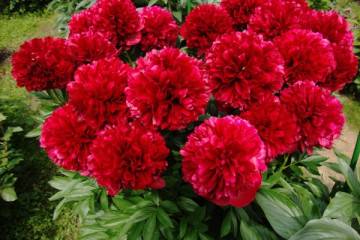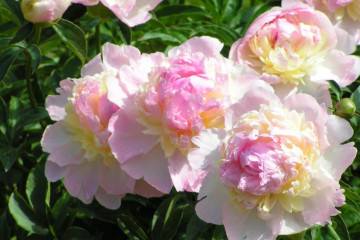Festival Maxima peony (Paeonia Festiva Maxima)
Content:
The Festiva Maxima peony is a cultivar bred by the French florists of the Miellerse florist in 1851. Over time, it became popular in all regions of Europe, as the climate in this area is the most favorable for growing peonies.
What is this variety, the history of creation
Paeonia Festiva Maxima is a tall shrub with spreading stems. The culture is able to inhabit the same area for 20-30 years, reaching a height of 1-1.5 meters. The bush has strong shoots covered with openwork dark green leaves. With the arrival of autumn, the foliage does not become habitually yellow, but, on the contrary, acquires a burgundy hue.
During the flowering period, the plant is covered with snow-white flowers with red tips in the center. The width of the flowers reaches 20-25 cm.
Milk-flowered peonies are often used by landscape designers. White peonies look beautiful in the center of group compositions, the main thing is that other plants are at a distance of no closer than a meter. White peonies are in good harmony with other, brighter crops, and also look advantageous against the background of conifers.
Growing a flower, how to plant it in open ground
Festival Maxima peony belongs to herbaceous crops. For planting, he needs a well-lit area. The distance to the nearest shading structures should be at least 2 meters.
Planting is carried out in early autumn, before the onset of frost. The acidity of the soil should be no more than 6.5 pH. It is not recommended to choose wetlands for this variety, otherwise excess moisture will provoke rotting of the root system. An increased level of soil acidity can be normalized by adding wood ash to it.
Landing order:
- Dig a planting hole 70 cm deep.
- Lay a drainage layer at the bottom, consisting of expanded clay and gravel.
- Mix the soil layer that remained from the pit with peat, humus and wood ash.
- Return the resulting soil mixture to the planting hole and leave it for 2 weeks.
After the time has elapsed, the cutting is planted in a hole so that the root collar is flush with the ground.
Plant care
Peony Paeonia Festiva Maxima is a moisture-loving plant. Watering the bush is carried out immediately after planting, and also within 5 weeks after it. To keep water in the soil, the trunk circle is mulched with peat. The mulch layer should be about 15 cm.
After 2-3 months, watering is allowed as needed. Do not forget that peonies do not tolerate excessive moisture. If the weather is cloudy and rainy, they stop watering them altogether.
In the first year or two, the peony is unlikely to please with flowering. However, during this period, the soil should be regularly loosened and cleaned of weeds. Starting from the third year, peonies gradually grow. During the flowering period, the stems can break, so they are tied to a support. Gardeners who grow peonies in regions with strong winds cannot do without special steel supports.
Peony Blossom Festival Maxim
Do not allow the plant to bloom in the first year, otherwise all forces will be spent on the formation of inflorescences, and the root system will begin to weaken. To prevent flowering, you should pinch off the buds that have appeared.
The first flowering occurs in the 2-3 year of the flower's life, in late spring-early summer and lasts from 7 to 20 days. At first, the plant not only blooms profusely, but also exudes a strong aroma. Over time, flowering becomes scarce or disappears altogether. This is due to the fact that the supply of nutrients is depleted. To prevent this from happening, you should periodically fertilize the bushes with mineral and organic fertilizers.
What to do after flowering
Peonies of the Festival Maxima variety feel great in one place up to 30 years, but after 10 years it is quite possible to transplant them. To do this, in the fall, the bush is dug up and carefully pulled out of the ground. After that, the rhizome is cleaned, washed and carefully examined. Then the roots are cut at an angle of 45 °, leaving a length of 10-15 cm.
Before transplanting, old bushes are split into several parts. This procedure is carried out in order to detect voids and rotten areas in the rhizome. The affected roots are treated with a solution of potassium permanganate and a fungicide, and then transplanted to another place.
Once the peonies have bloomed, further care is required. In early June, you need to cut off the faded head and stem to the first leaf. After 2 weeks, fertilize with phosphate fertilizers. The flower must be watered abundantly until autumn.
If in the current year young seedlings were planted or an old plant was transplanted, then it is necessary to mulch the near-trunk circle with a small layer of peat. This must be done so that weak peonies feel comfortable in winter and do not die. The ideal option is to use spruce branches, which are excellent protection against rodents and wind.
Diseases, pests and ways to control them
According to the description, peonies are unpretentious plants that are rarely exposed to diseases and pests. However, every gardener should be able to identify signs of disease in any plant growing on his site.
Peonies can be affected by:
- Gray rot is a disease that damages all parts of the plant. The buds and leaves are covered with gray mold, and the stems near the root collar are overgrown with brown spots. After the detection of the disease, the affected areas are cut and destroyed.
- Aphids are a greenish insect that drinks all the juices from the plant. If the peonies were attacked by a large number of aphids, then the flowers are immediately treated with Fitoverm or Aktellik.
In addition, flowers are often attacked by ants, beetles and caterpillars. Competent care of the plant will allow you to avoid such misfortunes.
Peony Festival Maxima is one of the most popular herbaceous crops. These flowers do not need special and complex care, but they will not leave anyone indifferent due to their decorative properties.


















